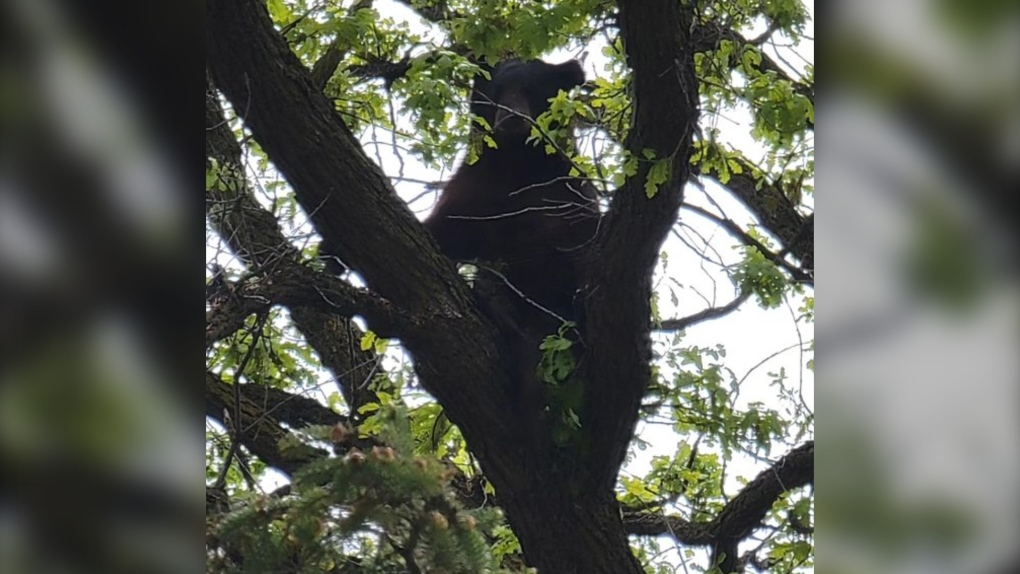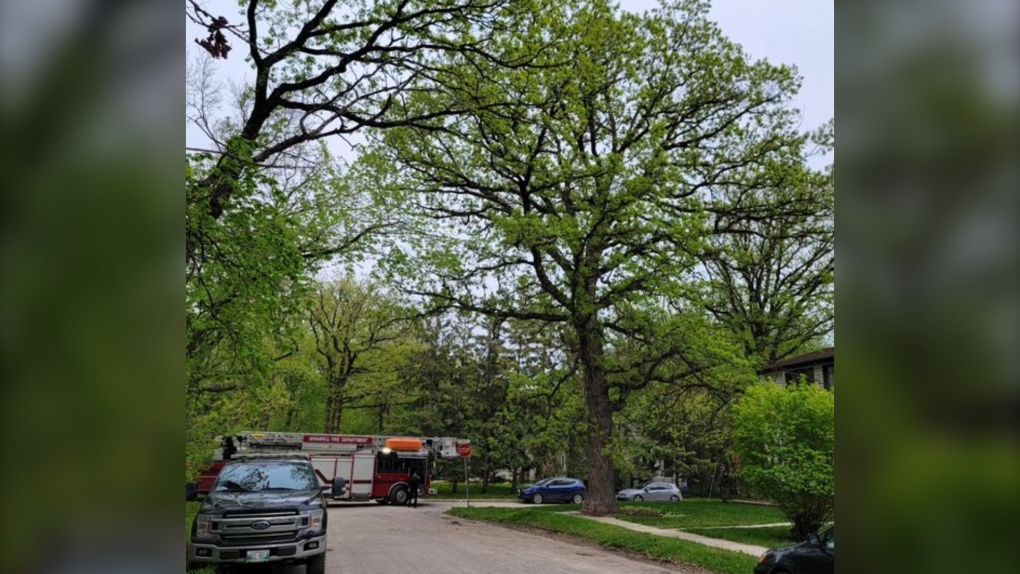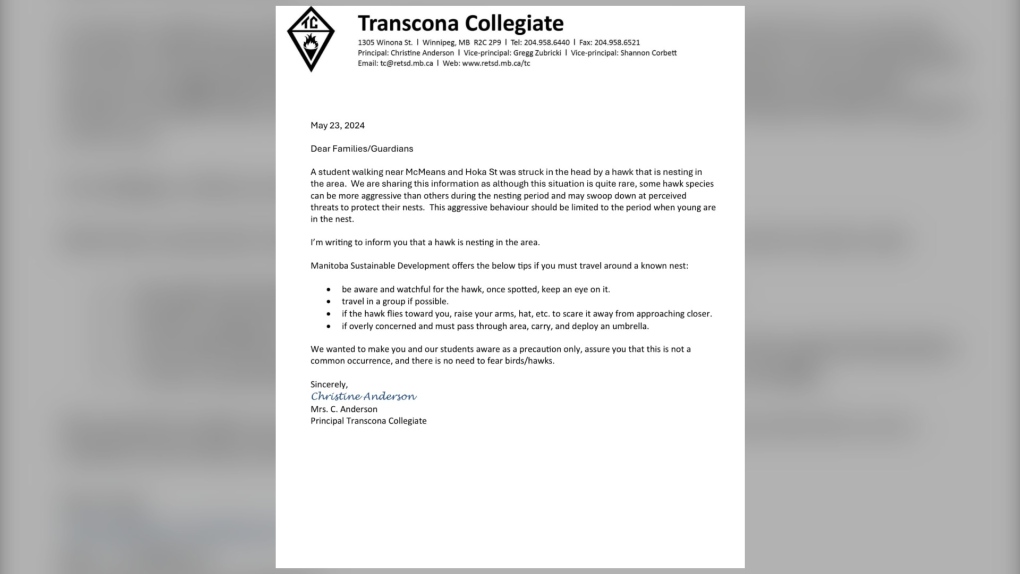‘It’s pretty alarming’: Urban wildlife encounters in Winnipeg this week
When you consider what kind of animals you might encounter in your Winnipeg neighborhood, a bear probably isn’t on your list.
But that’s exactly what residents of Wildwood stumbled upon on Tuesday.
A black bear was spotted roaming around the residential area.
“Living in Wildwood, it’s very normal to come across different types of animals and creatures within the neighbourhood," said area resident Nicholas Gray. "I was working from home and saw on Facebook that there was an alert of a black bear, which I thought was very surprising."
 A black bear up in a tree in Winnipeg's Wildwood neighbourhood on May 21, 2024 (Nicholas Gray)
A black bear up in a tree in Winnipeg's Wildwood neighbourhood on May 21, 2024 (Nicholas Gray)
“I've seen everything and anything that you could think of in the neighborhood,” he said, adding the bear eventually ended up in a very tall tree.
He said the bear’s choice to curl up at the top of a tree put a wrench in Manitoba Conservation’s plan to sedate it.
"The fire crew was there (and) they were talking about trying to get it into the bucket," Gray noted. "Because there were too many people around the base of the tree, the bear kept crawling up higher."
 WFPS responded to a bear in a tree in Wildwood on May 21, 2024 (Nicholas Gray)
WFPS responded to a bear in a tree in Wildwood on May 21, 2024 (Nicholas Gray)
"They didn't want to tranquillize it too high up for it to fall down, injure itself," he said. "It became basically a waiting game for nightfall for people to kind of go back home."
The hope was that the bear would eventually feel safe and come down on its own after the crowd had dispersed, Gray explained. But it was quite a surprise for him to see the wild creature on a city street, lingering so close to home.
“It's pretty alarming. I've got two dogs," he said, "It's a very open neighbourhood so my dogs are always off leash."
Gray said the dogs mostly ignore wildlife, like deer, but a bear would be a different story.
"I don't know what they would do if there was a bear wandering through my yard."
Hawk Attacks
The bear isn’t the only unusual display of wildlife in the city recently.
On Wednesday and Thursday, there were multiple reports of aggressive hawk attacks in Transcona’s McMeans Bay area.
It's not the first time the Transcona terror has struck.
Facebook users wrote of children attacked and warned others not to walk in the area without having their eyes on the skies.
Meanwhile, Transcona Collegiate issued a letter to families about one of its students experiencing an unpleasant hawk encounter.
“A student walking near McMeans and Hoka St. was struck in the head by a hawk that is nesting in the area,” wrote school principal Christine Anderson.
 A letter from Transcona Collegiate warning families about a hawk attack
A letter from Transcona Collegiate warning families about a hawk attack
She explained a potential reason for the hawk’s aggressive demeanour.
“We are sharing this information as although this situation is quite rare, some hawk species can be more aggressive than others during the nesting period and may swoop down at perceived threats to protect their nests. This aggressive behaviour should be limited to the period when young are in the nest. I’m writing to inform you that a hawk is nesting in the area,” said Anderson.
CTV contacted the province for comment, confirming hawk activity in Winnipeg.
“Manitoba Conservation has received three reports of incidents involving hawks and staff are in the process of installing signage to advise people to use caution in the area,” said a provincial spokesperson.
As for why the hawks haven’t been removed the spokesperson explained, “Legislation prevents the removal of the hawk, nestlings, and nest.”
If you find yourself in an area adjacent to a nest, the province noted there are a variety of ways to stay safe.
The simplest solution it says “is to give the nest a wide berth.”
It also suggests keeping a watchful eye on it hawks and travelling in a group if possible.
If a hawk flies towards you it recommends raising your arms, hats, etc. to scare it away from approaching closer.
And, if you must pass through the area, the province suggests wearing a hat and sunglasses, carrying and deploying an umbrella, and avoiding running or biking around the nest.
CTVNews.ca Top Stories

AS IT HAPPENED Wildfire reaches Jasper Wednesday night, causes 'significant loss'
One of two wildfires threatening Jasper National Park reached the townsite Wednesday night and caused 'significant loss.'
Alberta calls in army to assist with wildfire situation
Alberta has called in the Canadian Armed Forces to help assist with the worsening wildfire situation in the province.
Biden explains why he ended re-election bid in Oval Office address
U.S. President Joe Biden on Wednesday delivered a solemn call to voters to defend the country's democracy as he laid out in an Oval Office address his decision to drop his bid for reelection and throw his support behind Vice President Kamala Harris.
Barrie-Innisfil MPP 'blacked-out' and crashed car into window of child care centre
Staff at a Barrie child care centre say they are frustrated by what they call a local MPP's inadequate response after a car crashed through a window in one of the toddler rooms.
Norad intercepts Russian and Chinese bombers operating together near Alaska in apparent first
The North American Aerospace Defence Command (Norad) intercepted two Russian and two Chinese bombers flying near Alaska Wednesday in what appears to be the first time the two countries have been intercepted while operating together.
2 Canadians being 'sent home immediately,' removed from Olympic team after drone incident
An analyst and an assistant coach with Canada Soccer are being removed from the Canadian Olympic Team and 'sent home immediately,' according to the Canadian Olympic Committee.
An unwelcome attendee has joined the Paris Olympic Games: COVID-19
After a handful of Australian water polo players tested positive for COVID-19 this week, questions have emerged around how the spread of the disease will be mitigated at the Summer Olympic Games in Paris.
Vacations, meals, booze: Contractor used $100K of charity's money for personal expenses, B.C. court finds
A B.C. man who was hired to help a non-profit build a food hub but instead spent the money on personal expenses – including travel, restaurants, booze and cannabis – has been ordered to pay more than $120,000 in damages.
Male, female killed, 2 others injured in 'gun battle' outside Toronto plaza: police
Two people are dead and two others suffered serious injuries following a shooting that police have described as a 'gun battle' outside a plaza in Scarborough, Ont. early Wednesday morning.
































